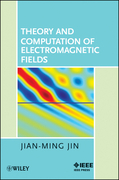
INDICE: Preface. PART I: ELECTROMAGNETIC FIELD THEORY. 1. Basic Electromagnetic Theory. 1.1 Review of Vector Analysis. 1.2 Maxwells Equations in Terms ofTotal Charges and Currents. 1.3 Constitutive Relations. 1.4 Maxwells Equations in Terms of Free Charges and Currents. 1.5 Boundary Conditions. 1.6 Energy, Power, and Poyntings Theorem. 1.7 Time-Harmonic Fields and Complex Power. References. Problems. 2. Electromagnetic Radiation in Free Space. 2.1 Scalar and Vector Potentials. 2.2 Solution of Vector Potentials in Free Space. 2.3 Electromagnetic Radiation in Free Space. 2.4 Radiation by Surface Currents and PhasedArrays. References. Problems. 3. Electromagnetic Theorems and Principles. 3.1Uniqueness Theorem. 3.2 Image Theory. 3.3 Reciprocity Theorems. 3.4 Equivalence Principles. 3.5 Duality Principle. 3.6 Aperture Radiation and Scattering. References. Problems. 4. Transmission Lines and Plane Waves. 4.1 Transmission Line Theory. 4.2 Wave Equation and General Solutions. 4.3 Plane Waves Generatedby a Current Sheet. 4.4 Reflection and Transmission. 4.5 Plane Waves in Anisotropic and Bi-Isotropic Media. References. Problems. 5. Fields and Waves in Rectangular Coordinates. 5.1 Uniform Waveguides. 5.2 Uniform Cavities. 5.3 Partially Filled Waveguides and Dielectric Slab Waveguides. 5.4 Field Excitation inWaveguides. 5.5 Fields in Planar Layered Media. References. Problems. 6. Fields and Waves in Cylindrical Coordinates. 6.1 Solution of Wave Equation. 6.2 Circular and Coaxial Waveguides and Cavities. 6.3 Circular Dielectric Waveguide.6.4 Wave Transformation and Scattering Analysis. 6.5 Radiation by Infinitely Long Currents. References. Problems. 7. Fields and Waves in Spherical Coordinates. 7.1 Solution of Wave Equation. 7.2 Spherical Cavity. 7.3 Biconical Antenna. 7.4 Wave Transformation and Scattering Analysis. 7.5 Addition Theorem and Radiation Analysis. References. Problems. PART II: ELECTROMAGNETIC FIELD COMPUTATION. 8. The Finite Difference Method. 8.1 Finite Differencing Formulas. 8.2 One-Dimensional Analysis. 8.3 Two-Dimensional Analysis. 8.4 Yees FDTD Scheme. 8.5 Absorbing Boundary Conditions. 8.6 Modeling of Dispersive Media. 8.7 Wave Excitation and Far-Field Calculation. 8.8 Summary. References. Problems. 9. The Finite Element Method. 9.1 Introduction to the Finite Element Method. 9.2 Finite Element Analysis of Scalar Fields. 9.3 Finite Element Analysis of Vector Fields. 9.4 Finite Element Analysis in the Time Domain. 9.5 Absorbing BoundaryConditions. 9.6 Some Numerical Aspects. 9.7 Summary. References. Problems. 10. The Method of Moments. 10.1 Introduction to the Method of Moments. 10.2 Two-Dimensional Analysis. 10.3 Three-Dimensional Analysis. 10.4 Analysis of Periodic Structures. 10.5 Analysis of Microstrip Antennas and Circuits. 10.6 The Moment Method in the Time Domain. 10.7 Summary. References. Problems. 11. Fast Algorithms and Hybrid Techniques. 11.1 Introduction to Fast Algorithms. 11.2 Conjugate Gradient-FFT Method. 11.3 Adaptive Integral Method. 11.4 Fast MultipoleMethod. 11.5 Adaptive Cross Approximation Algorithm. 11.6 Introduction to Hybrid Techniques. 11.7 Hybrid Finite Difference-Finite Element Method. 11.8 Hybrid Finite Element-Boundary Integral Method. 11.9 Summary. References. Problems. 12. Concluding Remarks on Computational Electromagnetics. 12.1 Overview of Computational Electromagnetics. 12.2 Applications of Computational Electromagnetics. 12.3 Challenges in Computational Electromagnetics. References. Index.
- ISBN: 978-0-470-53359-8
- Editorial: John Wiley & Sons
- Encuadernacion: Cartoné
- Páginas: 616
- Fecha Publicación: 03/12/2010
- Nº Volúmenes: 1
- Idioma: Inglés
